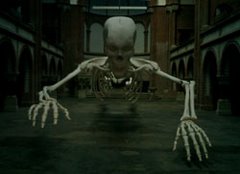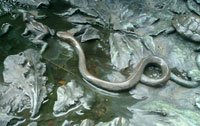 90 Black swans (Cygnus atratus) are to be shot on the edge of a protected wetland. Caught out in the middle of their breeding season, they are starving as the lakes have dried up. On the edge of their international protected refuge humans engage in “overstocking, over-grazing (and) the growth of rabbit populations, “. Forced to leave their 'dead wetland' these birds moved in on" some non-native greens. As some of ”the swans had trespassed onto a farmer's land adjacent to the Ramsar-listed wetland” they were declared a “pest” by authorities and permits were issued to shoot the protected Australian waterfowl.
90 Black swans (Cygnus atratus) are to be shot on the edge of a protected wetland. Caught out in the middle of their breeding season, they are starving as the lakes have dried up. On the edge of their international protected refuge humans engage in “overstocking, over-grazing (and) the growth of rabbit populations, “. Forced to leave their 'dead wetland' these birds moved in on" some non-native greens. As some of ”the swans had trespassed onto a farmer's land adjacent to the Ramsar-listed wetland” they were declared a “pest” by authorities and permits were issued to shoot the protected Australian waterfowl.East Gippsland in Victoria, Australia is where the forces of drought, severe floods and fires have for a long time stemmed the tide of irrigated dryland 'agriculture'. The “vulnerability” of human habitation, 'land management as usual ',mining and aqua-factories are on the cards. 'Pastoralists' and graziers seem to display a natural allergy against the conservation of public wetlands as a threat to their rights/territory.
The indigenous mythologies link black swans with their territory, the wetland, human practices and sustainable land-use strategies. Progressive encroachment on Aboriginal land and habitats of native wildlife followed. Accounts of 'vandalising the swans in the 'swamps', stealing eggs during their non-flying moulting season exist from 1882. Gould reported of whaling ships filled with black swans. Settlers and swans appeared already then as incompatible.
 A culture of culling entrenched itself on the southern continent. Native fauna was extracted from the land and water to divert these resources to introduced and often costly run-away fauna. Struggling to extract a European-like life-style out of the driest continent on Earth, which by then was undermined by their feral hopping rabbits, land erosion and sandstorms. A scapegoat had to be sacrificed in 1932 when farmers called in the army against starving emus in WA. 20,000 emus were gunned down by machine guns. Dingoes and kangaroos are being 'culled' today not to restore a non-existing agricultural paradigm, but to conquer habitat for human beings (and their dogs) exclusively.
A culture of culling entrenched itself on the southern continent. Native fauna was extracted from the land and water to divert these resources to introduced and often costly run-away fauna. Struggling to extract a European-like life-style out of the driest continent on Earth, which by then was undermined by their feral hopping rabbits, land erosion and sandstorms. A scapegoat had to be sacrificed in 1932 when farmers called in the army against starving emus in WA. 20,000 emus were gunned down by machine guns. Dingoes and kangaroos are being 'culled' today not to restore a non-existing agricultural paradigm, but to conquer habitat for human beings (and their dogs) exclusively.Today the culling go-ahead is issued to get Dingoes out of national parks and kangaroos out of the edge of towns. All space and resources have to become usable only by humans and their best friends. The flags and heraldry appear like mockery, boasting with unique Australian animals, such as the black swans, emus and kangaroos. The birds in the backyard are long gone, the backyard too.
 Should there be any survivors, the shooting of waterfowl (and other creatures) is a popular 'sport', this time by civilians. The severe drought, caused by self-inflicted climate change does at the moment not permit any massacres of birds. But the freedom of exemption is liberally taken in 'nature'. Both forms of 'recreational' killing of waterfowl and fish socialise large amounts of toxic lead into the water bodies and ecosystems. Waterbirds, if not mutilated or shot, suffer from the toxic lead run-off. The human community receives their dose later as it is dependent on the health of well managed wetlands. Some Victorian lakes receive up to 138 kg of lead p.a., a shooting range in the US gets contaminated with more” than 80,000 tons of lead shot and bullets each year.”
Should there be any survivors, the shooting of waterfowl (and other creatures) is a popular 'sport', this time by civilians. The severe drought, caused by self-inflicted climate change does at the moment not permit any massacres of birds. But the freedom of exemption is liberally taken in 'nature'. Both forms of 'recreational' killing of waterfowl and fish socialise large amounts of toxic lead into the water bodies and ecosystems. Waterbirds, if not mutilated or shot, suffer from the toxic lead run-off. The human community receives their dose later as it is dependent on the health of well managed wetlands. Some Victorian lakes receive up to 138 kg of lead p.a., a shooting range in the US gets contaminated with more” than 80,000 tons of lead shot and bullets each year.”Australian protected wetlands are too often utilised for purposes other than conservation of a biome. Dogs are allowed to roam and stress the waterfowl. Vehicles, boats and aircraft leave their pollution. (pdf) Energy intensive vehicles share the habitat of waterbirds generously, whether their owners are willing to share water or any other resource with 'wildlife' is another. Habitat destruction, “environmental mismanagement” and climate-induced drought is a challenge for Australian wetlands and their flora and fauna. "This is the beginning of the end for the lakes, but going out and slaughtering the wildlife is not the solution."
Images:
1. "Mulgo" (Black swan) by Port Jackson Painter, uploaded via Wikipedia
2. Image from Brockhaus' Kleines Konversations-Lexikon, via Zeno
3. Image from Brehm's Life of Animals. via Zeno
Rich Media:
Videos of Black Swans on IBC
Videos & info, Victoria - the place to be
Audio of Black swans, Birdguides
Links:
- Johne's disease,(Mycobacterium paratuberculosis) a serious wasting disease of introduced animals.
- Habitat Network East Gippsland
- 30 protected black swans (image!) and 35,000 ducks were shot as part of 'recreation' in Tasmania in 2006 abc.net, 30.11.07
Update 280708:
- United Nations University (2008, July 27). Rising Energy, Food Prices Major Threats To Wetlands As Farmers Eye New Areas For Crops. ScienceDaily. Retrieved July 28, 2008
- Ingestion of Spent Lead Ammunition:Implications for Wildlife and Humans, 2008 ( of blinded eagles from lead, starving)







